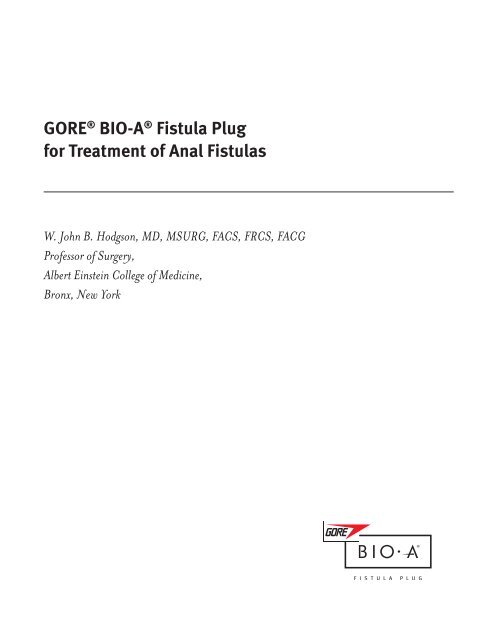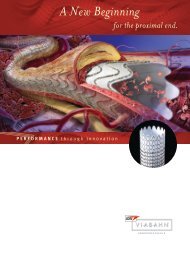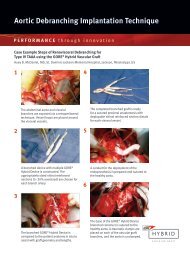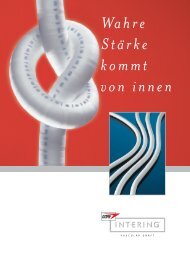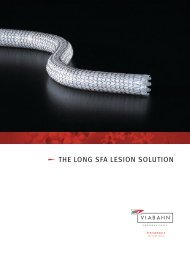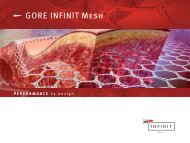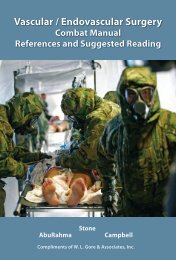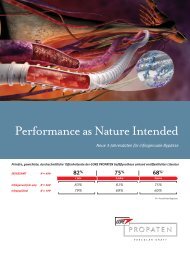GORE® BIO-A® Fistula Plug for Treatment of Anal ... - Gore Medical
GORE® BIO-A® Fistula Plug for Treatment of Anal ... - Gore Medical
GORE® BIO-A® Fistula Plug for Treatment of Anal ... - Gore Medical
Create successful ePaper yourself
Turn your PDF publications into a flip-book with our unique Google optimized e-Paper software.
GORE ® <strong>BIO</strong>-A ® <strong>Fistula</strong> <strong>Plug</strong><br />
<strong>for</strong> <strong>Treatment</strong> <strong>of</strong> <strong>Anal</strong> <strong>Fistula</strong>s<br />
W. John B. Hodgson, MD, MSURG, FACS, FRCS, FACG<br />
Pr<strong>of</strong>essor <strong>of</strong> Surgery,<br />
Albert Einstein College <strong>of</strong> Medicine,<br />
Bronx, New York
GORE ® <strong>BIO</strong>-A ® <strong>Fistula</strong> <strong>Plug</strong> <strong>for</strong> <strong>Treatment</strong> <strong>of</strong> <strong>Anal</strong> <strong>Fistula</strong>s<br />
<strong>Treatment</strong> <strong>of</strong> <strong>Anal</strong> <strong>Fistula</strong>s<br />
In the past, anal fistulas were treated by laying open the fistula tract (fistulotomy), a method that may have<br />
been used at least as long ago as the classical Roman era. Most practitioners preferred to open the tract<br />
widely enough so that the anal end <strong>of</strong> the fistula healed first. However, the more the anal sphincter is involved<br />
in the fistula, the greater the chance that surgical treatment will cause fecal incontinence. Because <strong>of</strong> this<br />
risk, surgeons began to use a silk ligature (seton), which was passed through the sphincter with the idea<br />
that the presence <strong>of</strong> the device would promote healing. There are two types <strong>of</strong> setons. A cutting seton is tied<br />
tightly and replaced with another tied seton when it loosens as the body extrudes it (a “slow fistulotomy”).<br />
A loose seton is placed only to facilitate drainage, thereby helping to control infection. 1 Seton-only therapy<br />
<strong>for</strong> anal fistulas is still used in some cases, but healing may take months and the treatment is associated<br />
with considerable pain, scarring <strong>of</strong> the perianal tissues, and fecal incontinence rates <strong>of</strong> up to 67%. 2<br />
Another alternative <strong>for</strong> treating anal fistulas is creation <strong>of</strong> an anal mucosal flap. Various types <strong>of</strong> flaps have<br />
been used, including tongue flaps, lip flaps, and tubular or sleeve flaps. The goal <strong>of</strong> all flap treatments is to<br />
cover the internal fistulous opening, blocking passage <strong>of</strong> fecal material into the fistula so that the tract can<br />
heal. Initially, secondary necrosis <strong>of</strong> flaps, with consequent reopening <strong>of</strong> the fistula, was common. To prevent<br />
necrosis, some surgeons cut into the internal sphincter, hoping that this would help maintain blood supply to<br />
the flap. However, the more the sphincter muscle is used as a flap, the higher the risk <strong>of</strong> fecal incontinence.<br />
Although healing rates in patients treated with a mucosal flap may be as high as 70%, 3 fecal incontinence<br />
rates have exceeded 25% in several series. 4-7<br />
Recently, various sphincter-sparing techniques <strong>for</strong> treating anal fistulas have been developed with the aim <strong>of</strong><br />
avoiding fecal incontinence. The first was instillation <strong>of</strong> fibrin glue, which was initially made at operation by<br />
the surgeon from the patient’s own blood but is now available commercially. Fibrin-glue treatment preserves<br />
continence, and the early experience with this method indicated that it was effective in achieving healing.<br />
However, as the procedure gained wide acceptance, success rates began to decrease, especially in patients<br />
with complex fistulas. Although success rates ranging from 14% to 74% have been reported, 8 the average is<br />
about 30% to 50%. 3,9,10<br />
The next sphincter-sparing method introduced was implantation <strong>of</strong> a collagen anal fistula plug (Surgisis ®<br />
[now called Biodesign ® ]; Cook <strong>Medical</strong>, Bloomington, IN), a device composed <strong>of</strong> lyophilized, decellularized<br />
porcine small-intestinal submucosa. We began to use this plug in 2007 and gained a good deal <strong>of</strong> experience<br />
with it. We found that it had certain faults, however, with the most important being a tendency to fall out,<br />
sometimes on the day <strong>of</strong> implantation or a few weeks later. Indeed, collagen-plug extrusion rates <strong>of</strong> about<br />
20% or higher have been observed in a number <strong>of</strong> studies, 7,11-13 including at least one randomized trial. 14<br />
In another randomized trial, the fistula recurrence rate after implantation <strong>of</strong> a collagen plug was 71%. 15<br />
In our practice, we inserted plastic buttons in an attempt to keep collagen plugs from falling out, but the<br />
buttons had several disadvantages: patients found them very uncom<strong>for</strong>table, they did not always prevent<br />
1
GORE ® <strong>BIO</strong>-A ® <strong>Fistula</strong> <strong>Plug</strong> <strong>for</strong> <strong>Treatment</strong> <strong>of</strong> <strong>Anal</strong> <strong>Fistula</strong>s<br />
plug extrusion, and some had to be removed surgically. Our success with the collagen plug was disappointing.<br />
We were able to achieve an overall success rate <strong>of</strong> 66%, but this was only by persistence in the face <strong>of</strong> failure;<br />
that is, when a fistula recurred, we put in another plug and, in some cases, healing then occurred. Use <strong>of</strong> a<br />
rubber draining seton or removal <strong>of</strong> granulation tissue from the fistula tract be<strong>for</strong>e placement <strong>of</strong> a collagen<br />
plug did not improve our results.<br />
The next sphincter-sparing innovation was the GORE ® <strong>BIO</strong>-A ® <strong>Fistula</strong> <strong>Plug</strong>, which was introduced into the<br />
US market in 2009. This plug is a completely synthetic prosthesis composed <strong>of</strong> polymers (polyglycolic acid/<br />
trimethylene carbonate [PGA/TMC]) that are gradually absorbed by the body. The PGA/TMC material has a<br />
three-dimensional matrix <strong>of</strong> open, interconnected pores that serves as a scaffold <strong>for</strong> tissue regeneration. The<br />
plug device consists <strong>of</strong> a disk to which three pairs <strong>of</strong> tubes or “legs” (a total <strong>of</strong> six) are attached. By removing<br />
one or more <strong>of</strong> the legs, the surgeon can tailor the plug to fit and fill a specific fistula, thereby possibly decreasing<br />
the likelihood <strong>of</strong> plug dislodgement and treatment failure. In a nonrandomized comparative study, the synthetic<br />
plug had a success rate that was more than four times higher than that <strong>of</strong> the collagen plug. 16 We have been<br />
using the GORE ® <strong>BIO</strong>-A ® <strong>Fistula</strong> <strong>Plug</strong> <strong>for</strong> 2 years and here describe our implantation technique and initial<br />
results with the device.<br />
Methods<br />
All patients with clinical evidence <strong>of</strong> a fistula undergo an<br />
endoanal ultrasound evaluation using hydrogen peroxide<br />
to confirm the diagnosis and detect tracts not observable<br />
clinically. A draining seton is placed until drainage stops and<br />
perineal pain has become minimal; this may take a few weeks<br />
to several months. Patients are given cefazolin (500 mg) and<br />
metronidazole (500 mg) be<strong>for</strong>e plug placement.<br />
Synthetic-plug implantation is per<strong>for</strong>med with the patient<br />
under spinal anesthesia and in the prone jackknife position<br />
with the buttocks taped apart. A 2-0 silk ligature is tied to<br />
the seton, which is then removed. The ligature is pulled<br />
through the fistula as the seton emerges. A piece <strong>of</strong> wet<br />
gauze (4 x 4 cm) is unrolled and the ligature is tied to it.<br />
The gauze is then pulled back and <strong>for</strong>th through the tract<br />
to remove granulation tissue.<br />
To treat single fistulas (Figures 1-4), we customarily use two<br />
legs <strong>of</strong> the synthetic plug (always from the same pair) and<br />
cut <strong>of</strong>f the other four. Although hydration <strong>of</strong> the plug is not<br />
Figure 1. The fistula tract is debrided <strong>of</strong> granulation tissue<br />
by pulling wet gauze back and <strong>for</strong>th within the tract.<br />
2
GORE ® <strong>BIO</strong>-A ® <strong>Fistula</strong> <strong>Plug</strong> <strong>for</strong> <strong>Treatment</strong> <strong>of</strong> <strong>Anal</strong> <strong>Fistula</strong>s<br />
Figure 2. The fistula plug is tailored to con<strong>for</strong>m to the<br />
fistula. Six “legs” (tubes) are available <strong>for</strong> filling the tract.<br />
Individual tubes can be removed to make the size <strong>of</strong> the<br />
device appropriate <strong>for</strong> the diameter <strong>of</strong> the tract.<br />
Figure 3. A suture tied to the end <strong>of</strong> the fistula plug is used<br />
to pull the entire device into the fistula tract.<br />
required, soaking it in saline <strong>for</strong> a few minutes after removal from its packaging will facilitate insertion<br />
because the device slides better when wet. The legs to be used are tied together with the silk ligature<br />
already in the fistula, and the entire plug device is pushed into the anal canal. Gentle traction is then<br />
employed to pull the ligature from the external orifice so that the legs pass through the tract. The disk<br />
part <strong>of</strong> the device ends up flush against the internal fistulous opening.<br />
Our plug-fixation technique involves burying the disk in a pocket created in the submucosa. The disk is<br />
pulled back from the fistula, and 1% lidocaine with epinephrine is pumped under the mucosa to create<br />
a space between the sphincter and mucosa to facilitate dissection. An incision slightly larger than the<br />
diameter <strong>of</strong> the disk is made, and a wide pocket is <strong>for</strong>med. The disk is slipped into the pocket, which is then<br />
closed by using 3-0 sutures placed at least 5 mm from the incision and with a 5-mm interval between them.<br />
Patients are generally scheduled to return <strong>for</strong> follow-up clinical evaluations 1, 2, and 6 weeks postoperatively<br />
and monthly thereafter until the fistula has healed or additional intervention is necessary. For nonhealing<br />
fistulas, the tract is injected with 3% hydrogen peroxide at each visit, with a blunt plastic cannula (usually<br />
size 18) used to access the persistent tract. Whether healing has occurred is determined by examining the<br />
perianal skin <strong>for</strong> fistula closure. The presence <strong>of</strong> even a small amount <strong>of</strong> drainage indicates that the fistula<br />
has not healed.<br />
3
GORE ® <strong>BIO</strong>-A ® <strong>Fistula</strong> <strong>Plug</strong> <strong>for</strong> <strong>Treatment</strong> <strong>of</strong> <strong>Anal</strong> <strong>Fistula</strong>s<br />
Results<br />
We have placed a GORE ® <strong>BIO</strong>-A ® <strong>Fistula</strong> <strong>Plug</strong> in 25<br />
patients with an overall success rate <strong>of</strong> 76.9% (32 anal<br />
fistula tracts): 19 men and 6 women (mean age, 46<br />
years [range, 31-77 years]). Eighteen <strong>of</strong> these patients<br />
(23 fistula tracts) have been followed <strong>for</strong> at least 6 months.<br />
Twelve <strong>of</strong> the 18 patients had healing, yielding a 66.6%<br />
patient success rate. Most <strong>of</strong> the healed patients were<br />
free <strong>of</strong> pain within 3 weeks <strong>of</strong> treatment. The per-fistula<br />
success rate in the series was 43.5%, reflecting the fact<br />
that multiple fistulas are more difficult to manage than<br />
one fistula. So far, no fistula recurrence has developed<br />
in the eight patients with a follow-up duration <strong>of</strong> less<br />
than 6 months. No plug in the series has migrated or<br />
fallen out.<br />
Figure 4. The fistula plug is pulled into the fistula tract<br />
from the internal to the external opening by using a suture<br />
attached to the end <strong>of</strong> the tubes. The device is fixed in place<br />
by burying the disk in a pocket created in the submucosa.<br />
Any tube segments protruding from the external opening<br />
are trimmed flush with the perianal skin.<br />
Some <strong>of</strong> the fistulas healed quite rapidly. For example,<br />
the patient shown in Figure 5 had bilateral fistula tracts<br />
and was treated with one plug (two pairs <strong>of</strong> legs). His<br />
pain resolved within a week, and both tracts healed<br />
within 2 weeks.<br />
“Our results with the relatively<br />
simple technique <strong>of</strong> implanting<br />
a synthetic fistula plug have<br />
been promising.”<br />
Figure 5. A multitract fistula is treated by dividing tubes<br />
from a single GORE® <strong>BIO</strong>-A® <strong>Fistula</strong> <strong>Plug</strong> between the<br />
tracts and pulling the device into place with a silk ligature.<br />
The tubes are then trimmed flush with the perianal skin.<br />
4
GORE ® <strong>BIO</strong>-A ® <strong>Fistula</strong> <strong>Plug</strong> <strong>for</strong> <strong>Treatment</strong> <strong>of</strong> <strong>Anal</strong> <strong>Fistula</strong>s<br />
Discussion<br />
Management <strong>of</strong> anal fistulas is multifactorial, but the most simple technique should be used initially because,<br />
if it works, complications associated with more complex procedures can be avoided. Un<strong>for</strong>tunately, many<br />
patients who are referred to us with unhealed fistulas have extensively incised perianal areas and hard<br />
subcutaneous scar tissue. Healing in the presence <strong>of</strong> scarring and fibrosis is always difficult to achieve,<br />
regardless <strong>of</strong> treatment method. Nevertheless, our results with the relatively simple technique <strong>of</strong> implanting<br />
a synthetic fistula plug have been promising.<br />
There has recently been an increase in interest in using ligation <strong>of</strong> the intersphincteric fistula tract (LIFT) to<br />
treat anal fistulas. The LIFT procedure, however, is far more invasive than insertion <strong>of</strong> a fistula plug because<br />
it involves a deep dissection in the posterior anal space that extends at least 1.5 cm from the internal<br />
fistulous orifice on all sides. Posteriorly, this deep space leads to the rectum, which, theoretically, could<br />
be injured during the dissection. Moreover, in women, in whom the upper end <strong>of</strong> the vagina is immediately<br />
anterior to the anus, there is a risk <strong>of</strong> injury that could result in a high rectovaginal fistula.<br />
Our aim has always been to keep surgical treatment <strong>of</strong> anal fistulas as minimally invasive as possible. We<br />
thus avoid use <strong>of</strong> the LIFT procedure and believe that success can be achieved with the following protocol:<br />
accurate pretreatment identification <strong>of</strong> the anatomical position and number <strong>of</strong> fistulas and fistula tracts by<br />
using endoanal ultrasonography or anal magnetic resonance imaging, keeping in mind that double tracts<br />
can be missed clinically, especially if they have the same entry and exit point; and implantation <strong>of</strong> a GORE ®<br />
<strong>BIO</strong>-A ® <strong>Fistula</strong> <strong>Plug</strong>, with care taken to place the disk portion <strong>of</strong> the device in a very large pocket. We think<br />
that completely covering the disk contributed to the dramatically accelerated healing and quick resolution<br />
<strong>of</strong> pain in our most recent cases.<br />
5
References<br />
1. Malik AI, Nelson RL. Surgical management <strong>of</strong> anal fistulae: a systematic review. Colorectal Dis. 2008;10(5):420-430.<br />
2. Dudukgian H, Abcarian G. Why do we have so much trouble treating anal fistula? World J Gastroenterol. 2011;17(28):3292-3296.<br />
3. de Parades V, Zeitoun J-D, Atienza P. Cryptoglandular anal fistula. J Visc Surg. 2010;147(4):e203-e215.<br />
4. Roig JV, Jordán J, García-Armengol J, Esclapez P, Solana A. Changes in anorectal morphologic and functional parameters after fistula-in-ano surgery.<br />
Dis Colon Rectum. 2009;52(8):1462-1469.<br />
5. van der Hagen SJ, Baeten CG, Soeters PB, van Gemert WG. Long-term outcome following mucosal advancement flap <strong>for</strong> high perianal<br />
fistulas and fistulotomy <strong>for</strong> low perianal fistulas: recurrent perianal fistulas: failure <strong>of</strong> treatment or recurrent patient disease? Int J Colorectal Dis.<br />
2006;21(8):784-790.<br />
6. van Koperen PJ, Wind J, Bemelman WA, Bakx R, Reitsma JB, Slors JF. Long-term functional outcome and risk factors <strong>for</strong> recurrence after surgical<br />
treatment <strong>for</strong> low and high perianal fistulas <strong>of</strong> cryptoglandular origin. Dis Colon Rectum. 2008;51(10):1475-1481.<br />
7. Christo<strong>for</strong>idis D, Pieh MC, Mad<strong>of</strong>f RD, Mellgren AF. <strong>Treatment</strong> <strong>of</strong> transsphincteric anal fistulas by endorectal advancement flap or collagen fistula<br />
plug: a comparative study. Dis Colon Rectum. 2009;52(1):18-22.<br />
8. Deeba S, Aziz O, Sains PS, Darzi A. <strong>Fistula</strong>-in-ano: advances in treatment. Am J Surg. 2008;196(1):95-99.<br />
9. Shawki S, Wexner SD. Idiopathic fistula-in-ano. World J Gastroenterol. 2011;17(28):3277-3285.<br />
10. Rizzo JA, Naig AL, Johnson EK. Anorectal abscess and fistula-in-ano: evidence-based management. Surg Clin North Am. 2010;90(1):45-68.<br />
11. Garg P. To determine the efficacy <strong>of</strong> anal fistula plug in the treatment <strong>of</strong> high fistula-in-ano: an initial experience. Colorectal Dis. 2009;11(6):588-591.<br />
12. El-Gazzaz G, Zutshi M, Hull T. A retrospective review <strong>of</strong> chronic anal fistulae treated by anal fistulae plug. Colorectal Dis. 2010;12(5):442-447.<br />
13. Kleif H, Hagen K, Wille-Jørgensen P. Acceptable results using plug <strong>for</strong> the treatment <strong>of</strong> complex anal fistulas. Dan Med Bull. 2011;58(3):A4254.<br />
14. Ortiz H, Marzo J, Ciga MA, Oteiza F, Armendáriz P, de Miguel M. Randomized clinical trial <strong>of</strong> anal fistula plug versus endorectal advancement flap<br />
<strong>for</strong> the treatment <strong>of</strong> high cryptoglandular fistula in ano. Br J Surg. 2009;96(6):608-612.<br />
15. van Koperen PJ, Bemelman WA, Gerhards MF, Janssen LW, van Tets WF, van Dalsen AD, Slors JF. The anal fistula plug treatment compared with<br />
the mucosal advancement flap <strong>for</strong> cryptoglandular high transsphincteric perianal fistula: a double-blinded multicenter randomized trial.<br />
Dis Colon Rectum. 2011;54(4):387-393.<br />
16. Buchberg B, Masoomi H, Choi J, Bergman H, Mills S, Stamos MJ. A tale <strong>of</strong> two (anal fistula) plugs: is there a difference in short-term outcomes?<br />
Am Surg. 2010;76(10):1150-1153.<br />
6
W. L. <strong>Gore</strong> & Associates, Inc.<br />
Flagstaff, AZ 86004<br />
+65.67332882 (Asia Pacific) 800.437.8181 (United States)<br />
00800.6334.4673 (Europe) 928.779.2771 (United States)<br />
goremedical.com<br />
Products listed may not be available in all markets.<br />
GORE ® , <strong>BIO</strong>-A ® , and designs are trademarks <strong>of</strong> W. L. <strong>Gore</strong> & Associates.<br />
Biodesign ® and Surgisis ® are registered trademarks <strong>of</strong> Cook <strong>Medical</strong>,<br />
© 2012 W. L. <strong>Gore</strong> & Associates, Inc. AR2422-EN1 FEBRUARY 2012


